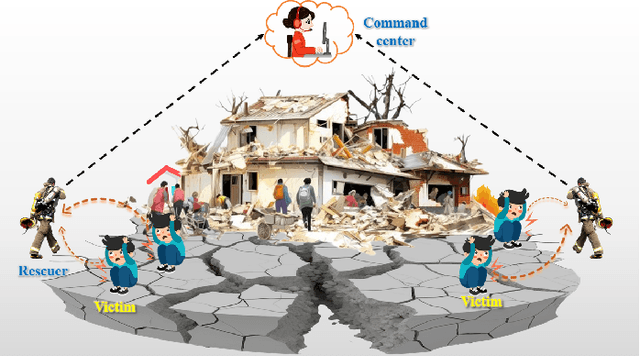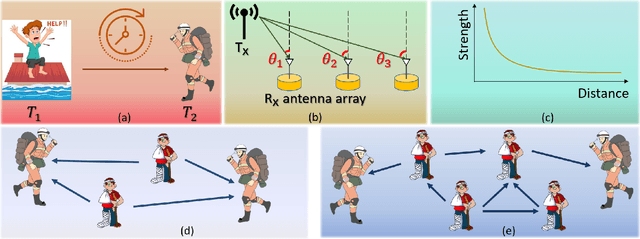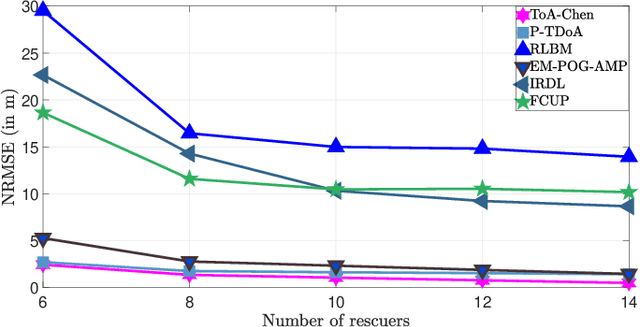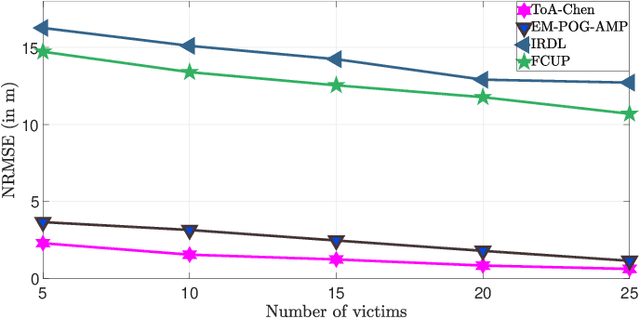Mohamed-Slim Alouini
Machine Learning-based Path Loss Prediction in Suburban Environment in the Sub-6 GHz Band
Oct 01, 2025Abstract:Accurate path loss (PL) prediction is crucial for successful network planning, antenna design, and performance optimization in wireless communication systems. Several conventional approaches for PL prediction have been adopted, but they have been demonstrated to lack flexibility and accuracy. In this work, we investigate the effectiveness of Machine Learning (ML) models in predicting PL, particularly for the sub-6 GHz band in a suburban campus of King Abdullah University of Science and Technology (KAUST). For training purposes, we generate synthetic datasets using the ray-tracing simulation technique. The feasibility and accuracy of the ML-based PL models are verified and validated using both synthetic and measurement datasets. The random forest regression (RFR) and the K-nearest neighbors (KNN) algorithms provide the best PL prediction accuracy compared to other ML models. In addition, we compare the performance of the developed ML-based PL models with the traditional propagation models, including COST-231 Hata, Longley-Rice, and Close-in models. The results show the superiority of the ML-based PL models compared to conventional models. Therefore, the ML approach using the ray-tracing technique can provide a promising and cost-effective solution for predicting and modeling radio wave propagation in various scenarios in a flexible manner.
Retrieval-Augmented Generation for Reliable Interpretation of Radio Regulations
Sep 11, 2025Abstract:We study question answering in the domain of radio regulations, a legally sensitive and high-stakes area. We propose a telecom-specific Retrieval-Augmented Generation (RAG) pipeline and introduce, to our knowledge, the first multiple-choice evaluation set for this domain, constructed from authoritative sources using automated filtering and human validation. To assess retrieval quality, we define a domain-specific retrieval metric, under which our retriever achieves approximately 97% accuracy. Beyond retrieval, our approach consistently improves generation accuracy across all tested models. In particular, while naively inserting documents without structured retrieval yields only marginal gains for GPT-4o (less than 1%), applying our pipeline results in nearly a 12% relative improvement. These findings demonstrate that carefully targeted grounding provides a simple yet strong baseline and an effective domain-specific solution for regulatory question answering. All code and evaluation scripts, along with our derived question-answer dataset, are available at https://github.com/Zakaria010/Radio-RAG.
Toward Sustainable Subterranean mMTC: Space-Air-Ground-Underground Networks Powered by LoRaWAN and Wireless Energy Transfer
Aug 20, 2025Abstract:Wireless underground sensor networks (WUSNs), which enable real-time sensing and monitoring of underground resources by underground devices (UDs), hold great promise for delivering substantial social and economic benefits across various verticals. However, due to the harsh subterranean environment, scarce network resources, and restricted communication coverage, WUSNs face significant challenges in supporting sustainable massive machine-type communications (mMTC), particularly in remote, disaster-stricken, and hard-to-reach areas. To complement this, we conceptualize in this study a novel space-air-ground-underground integrated network (SAGUIN) architecture that seamlessly incorporates satellite systems, aerial platforms, terrestrial networks, and underground communications. On this basis, we integrate LoRaWAN and wireless energy transfer (WET) technologies into SAGUIN to enable sustainable subterranean mMTC. We begin by reviewing the relevant technical background and presenting the architecture and implementation challenges of SAGUIN. Then, we employ simulations to model a remote underground pipeline monitoring scenario to evaluate the feasibility and performance of SAGUIN based on LoRaWAN and WET technologies, focusing on the effects of parameters such as underground conditions, time allocation, LoRaWAN spread factor (SF) configurations, reporting periods, and harvested energy levels. Our results evidence that the proposed SAGUIN system, when combined with the derived time allocation strategy and an appropriate SF, can effectively extend the operational lifetime of UDs, thereby facilitating sustainable subterranean mMTC. Finally, we pinpoint key challenges and future research directions for SAGUIN.
Native-AI Empowered Scalable Architectures and Solutions for Future Non-Terrestrial Networks: An Overview
Jul 16, 2025Abstract:As the path toward 6G networks is being charted, the emerging applications have motivated evolutions of network architectures to realize the efficient, reliable, and flexible wireless networks. Among the potential architectures, the non-terrestrial network (NTN) and open radio access network (ORAN) have received increasing interest from both academia and industry. Although the deployment of NTNs ensures coverage, enhances spectral efficiency, and improves the resilience of wireless networks. The high altitude and mobility of NTN present new challenges in the development and operations (DevOps) lifecycle, hindering intelligent and scalable network management due to the lack of native artificial intelligence (AI) capability. With the advantages of ORAN in disaggregation, openness, virtualization, and intelligence, several works propose integrating ORAN principles into the NTN, focusing mainly on ORAN deployment options based on transparent and regenerative systems. However, a holistic view of how to effectively combine ORAN and NTN throughout the DevOps lifecycle is still missing, especially regarding how intelligent ORAN addresses the scalability challenges in NTN. Motivated by this, in this paper, we first provide the background knowledge about ORAN and NTN, outline the state-of-the-art research on ORAN for NTNs, and present the DevOps challenges that motivate the adoption of ORAN solutions. We then propose the ORAN-based NTN framework, discussing its features and architectures in detail. These include the discussion about flexible fronthaul split, RAN intelligent controllers (RICs) enhancement for distributed learning, scalable deployment architecture, and multi-domain service management. Finally, the future research directions, including combinations of the ORAN-based NTN framework and other enabling technologies and schemes, as well as the candidate use cases, are highlighted.
From Ground to Sky: Architectures, Applications, and Challenges Shaping Low-Altitude Wireless Networks
Jun 14, 2025Abstract:In this article, we introduce a novel low-altitude wireless network (LAWN), which is a reconfigurable, three-dimensional (3D) layered architecture. In particular, the LAWN integrates connectivity, sensing, control, and computing across aerial and terrestrial nodes that enable seamless operation in complex, dynamic, and mission-critical environments. In this article, we introduce a novel low-altitude wireless network (LAWN), which is a reconfigurable, three-dimensional (3D) layered architecture. Different from the conventional aerial communication systems, LAWN's distinctive feature is its tight integration of functional planes in which multiple functionalities continually reshape themselves to operate safely and efficiently in the low-altitude sky. With the LAWN, we discuss several enabling technologies, such as integrated sensing and communication (ISAC), semantic communication, and fully-actuated control systems. Finally, we identify potential applications and key cross-layer challenges. This article offers a comprehensive roadmap for future research and development in the low-altitude airspace.
Design of 3D Beamforming and Deployment Strategies for ISAC-based HAPS Systems
Jun 12, 2025Abstract:This paper explores high-altitude platform station (HAPS) systems enabled by integrated sensing and communication (ISAC), in which a HAPS simultaneously transmits communication signals and synthetic aperture radar (SAR) imaging signals to support multi-user communication while performing ground target sensing. Taking into account the operational characteristics of SAR imaging, we consider two HAPS deployment strategies: (i) a quasi-stationary HAPS that remains fixed at an optimized location during SAR operation, following the stop-and-go scanning model; and (ii) a dynamic HAPS that continuously adjusts its flight trajectory along a circular path. For each strategy, we aim at maximizing the weighted sum-rate throughput for communication users while ensuring that SAR imaging requirements, such as beampattern gain and signal-to-noise ratio (SNR), are satisfied. This is achieved by jointly optimizing the HAPS deployment strategy, i.e., its placement or trajectory, along with three-dimensional (3D) transmit beamforming, under practical constraints including transmit power limits, energy consumption, and flight dynamics. Nevertheless, the formulated optimization problems corresponding to the two deployment strategies are inherently non-convex. To address the issue, we propose efficient algorithms that leverage both convex and non-convex optimization techniques to obtain high-quality suboptimal solutions. Numerical results demonstrate the effectiveness and advantages of the proposed approaches over benchmark schemes.
Super-LoRa: Enhancing LoRa Throughput via Payload Superposition
Apr 16, 2025Abstract:This paper presents Super-LoRa, a novel approach to enhancing the throughput of LoRa networks by leveraging the inherent robustness of LoRa modulation against interference. By superimposing multiple payload symbols, Super-LoRa significantly increases the data rate while maintaining lower transmitter and receiver complexity. Our solution is evaluated through both simulations and real-world experiments, showing a potential throughput improvement of up to 5x compared to standard LoRa. This advancement positions Super-LoRa as a viable solution for data-intensive IoT applications such as smart cities and precision agriculture, which demand higher data transmission rates.
GPS-Independent Localization Techniques for Disaster Rescue
Apr 14, 2025



Abstract:In this article, we present the limitations of traditional localization techniques, such as those using Global Positioning Systems (GPS) and life detectors, in localizing victims during disaster rescue efforts. These techniques usually fall short in accuracy, coverage, and robustness to environmental interference. We then discuss the necessary requirements for developing GPS-independent localization techniques in disaster scenarios. Practical techniques should be passive, with straightforward hardware, low computational demands, low power, and high accuracy, while incorporating unknown environmental information. We review various implementation strategies for these techniques, categorized by measurements (time, angle, and signal strength) and operation manners (non-cooperative and cooperative). Case studies demonstrate trade-offs between localization accuracy and complexity, emphasizing the importance of choosing appropriate localization techniques based on resources and rescue needs for efficient disaster response.
Macroscale Molecular Communication in IoT-based Pipeline Inspection and Monitoring Applications: Preliminary Experiment and Mathematical Model
Apr 12, 2025Abstract:Today, pipeline networks serve as critical infrastructure for transporting materials such as water, gas, and oil. Modern technologies such as the Internet of Things (IoT), sensor nodes, and inspection robots enable efficient pipeline monitoring and inspection. They can help detect and monitor various conditions and defects in pipelines such as cracks, corrosion, leakage, pressure, flow, and temperature. Since most pipelines are buried underground, wireless communication links suffer from significant attenuation and noise due to harsh environmental conditions. In such systems, communication links are required between the sensor nodes as well as between the external control/monitoring unit or sensor node and the inspection robot inside the pipeline. In this paper, we propose a macroscale molecular communication (MC) system in the IoT-based pipeline inspection and monitoring networks to address this challenge. We develop a mathematical model and implement a preliminary experimental testbed to validate the system and demonstrate its feasibility by transmitting and reconstructing binary sequences using volatile organic compound (VOC) as an information signal. We examined the impact of various system parameters including airflow carrier velocity, released VOC velocity, emission duration, and bit duration. Results indicate that these parameters significantly influence the received molecular signal, emphasizing the need for optimal configuration. This work serves as a preliminary step for further research on the application of MC in IoT-based pipeline inspection and monitoring systems.
Performance and Complexity Analysis of Terahertz-Band MIMO Detection
Apr 07, 2025Abstract:Achieving terabit-per-second (Tbps) data rates in terahertz (THz)-band communications requires bridging the complexity gap in baseband transceiver design. This work addresses the signal processing challenges associated with data detection in THz multiple-input multiple-output (MIMO) systems. We begin by analyzing the trade-offs between performance and complexity across various detection schemes and THz channel models, demonstrating significant complexity reduction by leveraging spatial parallelizability over subspaces of correlated THz MIMO channels. We derive accurate detection error probability bounds by accounting for THz-specific channel models and mismatches introduced by subspace decomposition. Building on this, we propose a subspace detector that integrates layer sorting, QR decomposition, and channel-matrix puncturing to balance performance loss and parallelizability. Furthermore, we introduce a channel-matrix reuse strategy for wideband THz MIMO detection. Simulations over accurate, ill-conditioned THz channels show that efficient parallelizability achieves multi-dB performance gains, while wideband reuse strategies offer computational savings with minimal performance degradation.
 Add to Chrome
Add to Chrome Add to Firefox
Add to Firefox Add to Edge
Add to Edge